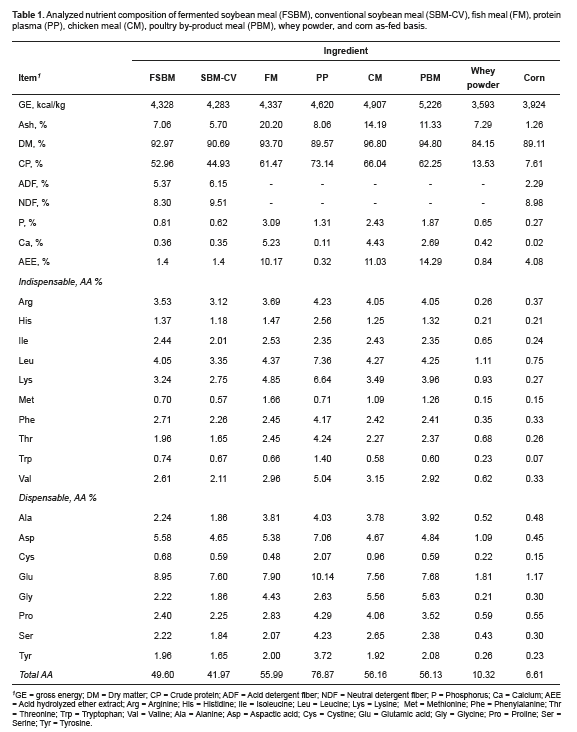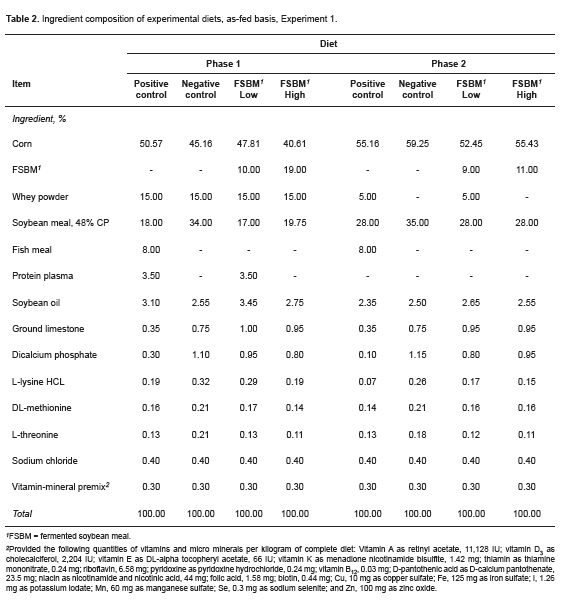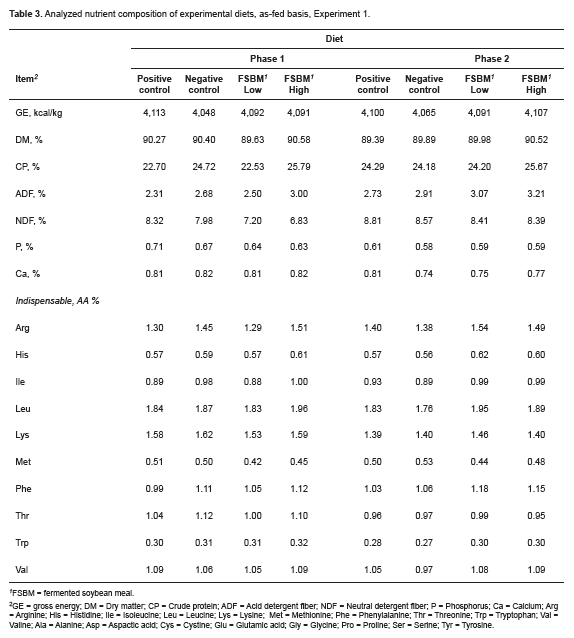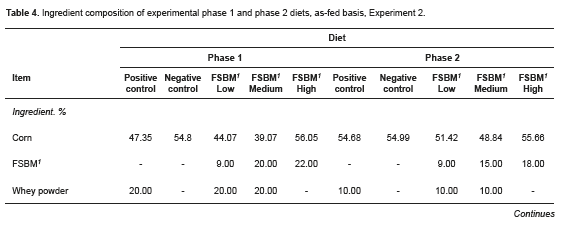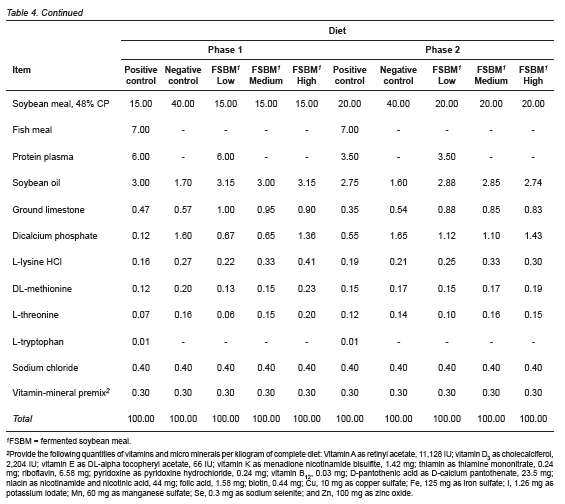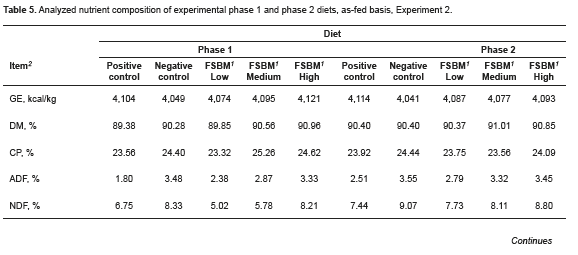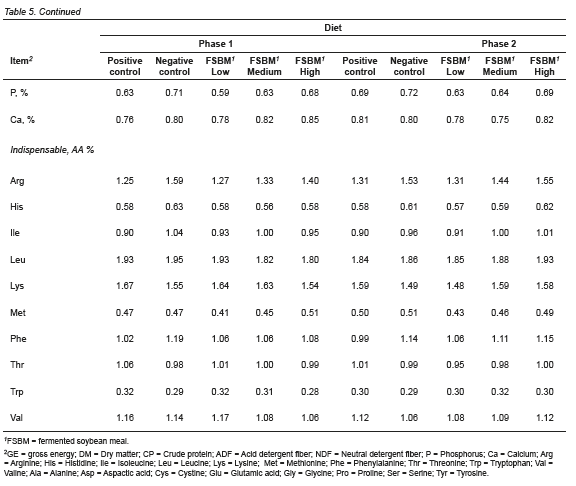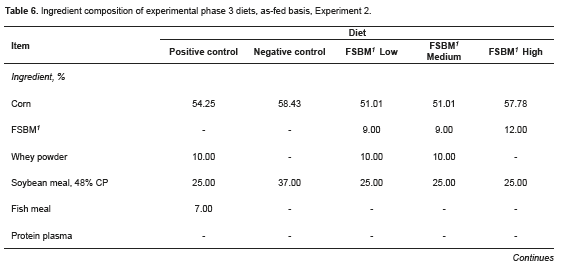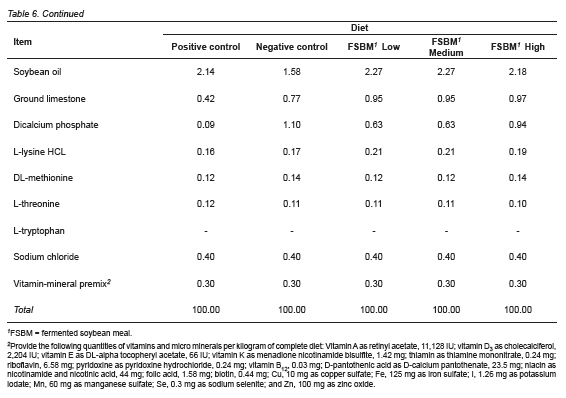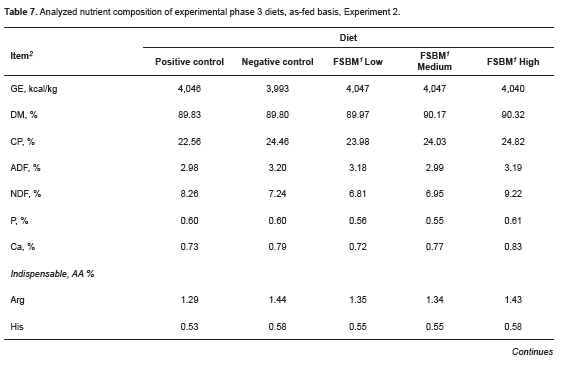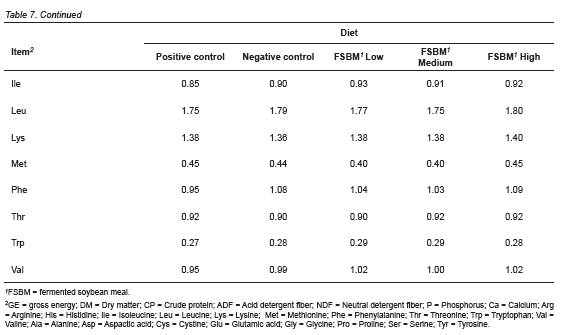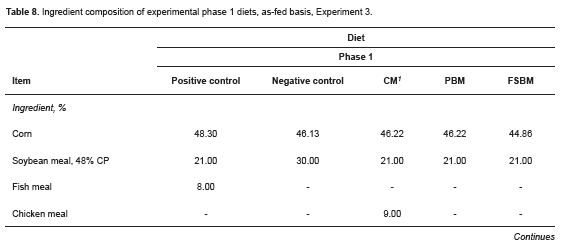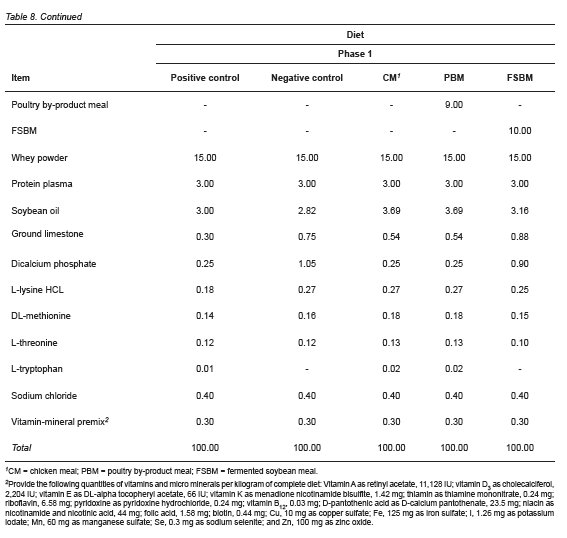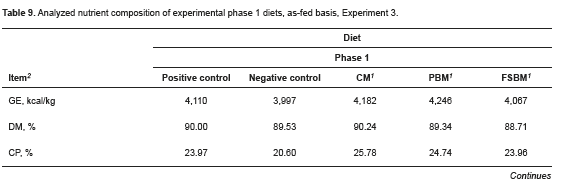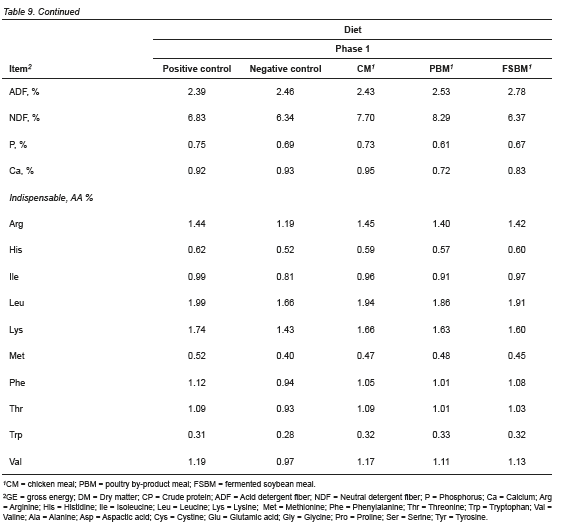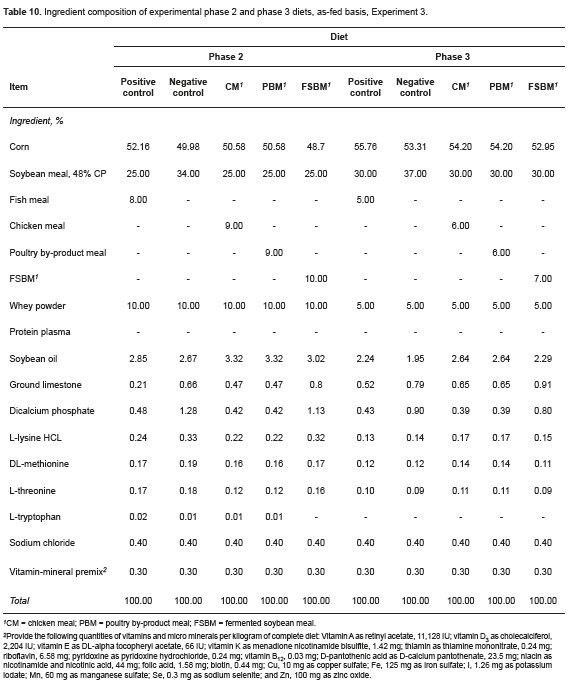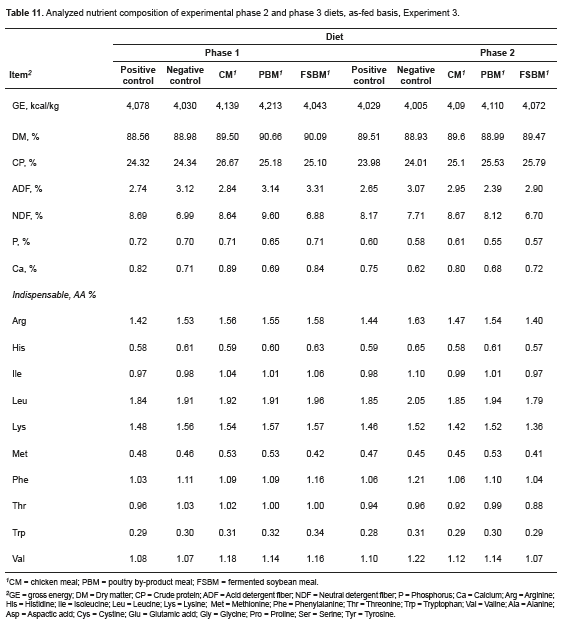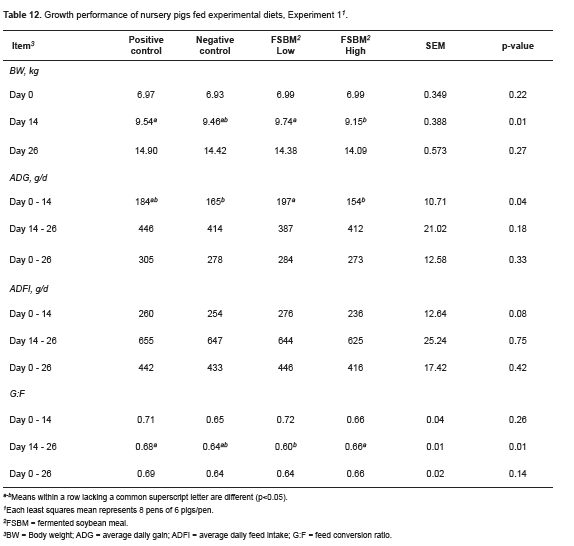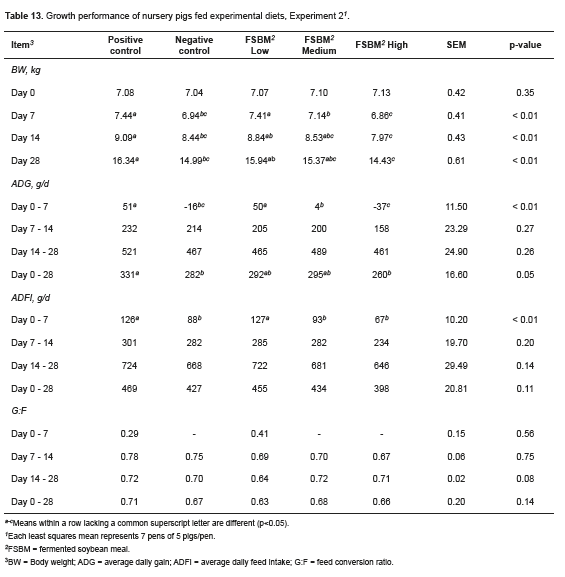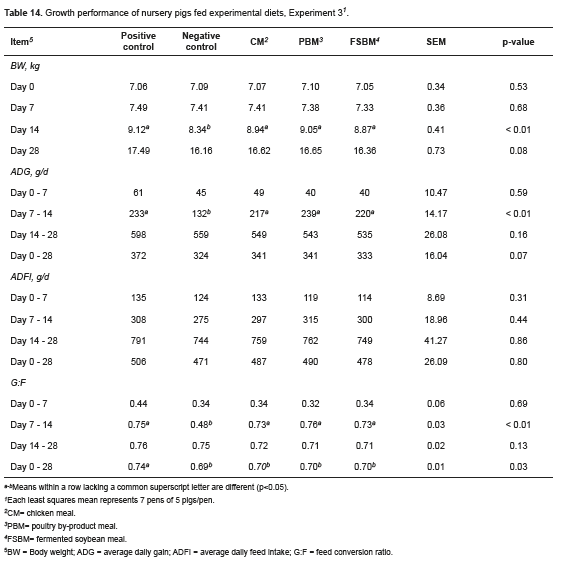Services on Demand
Journal
Article
Indicators
-
 Cited by SciELO
Cited by SciELO -
 Access statistics
Access statistics
Related links
-
 Cited by Google
Cited by Google -
 Similars in
SciELO
Similars in
SciELO -
 Similars in Google
Similars in Google
Share
Revista Colombiana de Ciencias Pecuarias
Print version ISSN 0120-0690
Rev Colom Cienc Pecua vol.28 no.1 Medellín Jan./Mar. 2015
ARTICLE
Effects of replacing fish, chicken, or poultry by-product meal with fermented soybean meal in diets fed to weanling pigs¤
Efectos del reemplazo de harina de pescado, pollo, o sub-productos de pollo con harina de soja fermentada en dietas suministradas a cerdos destetados
Efeito da substituição de farinha de peixe, farinha de frango ou sub-produtos do frango pela soja integral fermentada em dietas de leitões pós desmame
Oscar J Rojas, Zoot, MSc; Hans. H. Stein*, MSc, PhD.
Department of Animal Sciences, University of Illinois, Urbana, IL 61801, USA.
*Corresponding author: Hans H Stein. Department of Animal Sciences, University of Illinois, 1207 W. Gregory Drive, Urbana, IL 61801, USA. Email: hstein@illinois.edu.
Received: June 13, 2013; accepted: March 18, 2014
Summary
Background: tfermented soybean meal (FSBM) by virtue of its method of processing has lost some antinutritional factors such as some oligosaccharides and antigens. Therefore, it is possible to include FSBM in weanling pig diets to replace fish meal (FM), chicken meal (CM), or poultry by-product meal (PBM).Objective: three experiments were conducted to test the hypothesis that FSBM may replace FM, CM, or PBM in diets fed to weanling pigs. Methods: in Experiment 1, a total of 192 pigs (initial BW: 6.88 kg) were randomly allotted to 4 dietary treatments: negative control (NC) and positive control (PC) without or with FM and protein plasma; low level of FSBM replacing FM, and high level of FSBM replacing FM and protein plasma. In Experiment 2, a total of 175 pigs (initial BW: 6.86 kg) were randomly allotted to 5 dietary treatments, which were similar as Experiment 1 but with 3 levels of FSBM. In Experiment 3, 175 pigs (initial BW: 6.97 kg) were allotted to 5 dietary treatments: NC, FM diet, chicken meal (CM) diet, poultry by-product meal (PBM) diet, and FSBM diet. Results: the final BW of the pigs in each experiment was not different among treatments, except for Experiment 2 in which adding high level of FSBM reduced final BW (p<0.05). Likewise, the G:F (feed conversion efficiency) for the overall experiment were not different among treatments in Experiments 1 and 2. However, in Experiment 3, G:F was greater (p<0.05) for pigs fed FM diet than for pigs fed other diets, but G:F was not different among pigs fed CM, PBM, or FSBM diet. Conclusion: fermented soybean meal may replace FM, CM, or PBM in diets fed to pigs during 4 week post-weaning period without affecting pig growth performance.
Keywords: anti-nutritional factors, fermented grains, growth, growth performance, protein sources, swine nutrition.
Resumen
Antecedentes: la harina de soya fermentada (FSBM) debido a su método de procesamiento pierde algunos de los factores anti-nutricionales como son los oligosacáridos y antígenos. Por lo tanto, es posible incluir FSBM en dietas a cerdos post-destetados reemplazando harina de pescado (FM), harina de pollo (CM) o harina de sub-productos de pollo (PBM). Objetivo: tres experimentos fueron conducidos para probar la hipótesis de que FSBM podría reemplazar FM, CM o PBM en dietas de cerdos destetados. Métodos:en el Experimento 1, un total de 192 cerdos (peso inicial BW: 6,88 kg) fueron aleatoriamente asignados a 4 tratamientos dietarios: control negativo (NC) y control positivo (PC), sin o con FM y plasma proteica, bajo nivel de FSBM en reemplazo de FM y alto nivel de FSBM reemplazo FM y plasma proteica. En el Experimento 2, un total de 175 cerdos (peso inicial BW: 6,86 kg) fueron asignados a 5 tratamientos dietarios, los cuales fueron similares al Experimento 1 pero con 3 niveles de FSBM. En el Experimento 3 un total de 175 cerdos (peso inicial BW: 6,97 kg) fueron asignados a los siguiente tratamientos dietarios: NC, FSBM, CM, PBM y FSBM. Resultados: el peso final de los cerdos en cada uno de los experimentos no fue diferente entre los tratamientos, excepto en el Experimento 2 en el cual la adición de altos niveles de FSBM redujeron el peso final (p<0.05). Así mismo, la eficiencia alimenticia de todo el experimento no fue diferente entre los tratamientos en los Experimentos 1 y 2. Sin embargo, en el Experimento 3, la conversión alimenticia fue mayor (p<0.01) en cerdos alimentados con dietas con FM comparado con cerdos alimentados con los otros tratamientos, pero no fue diferente entre cerdos alimentados con CM, PBM o FSBM. Conclusión: la harina de soya fermentada podría reemplazar FM, CM o PBM en dietas de cerdos durante 4 semanas post-desdete sin afectar el desempeño de crecimiento.
Palabras clave: crecimiento, factores anti-nutricionales, fuentes de proteína, granos fermentados, nutrición porcina, rendimiento productivo.
Resumo
Antecedentes: o processo de obtenção da soja integral fermentada (FSBM) resulta em perda de alguns fatores anti nutricionais como oligossacarídeos e antígenos. Consequentemente, é possivel incluir FSBM em dietas de leitões recém-desmamados em substituição a farinha de peixe (FM), farinha de vísceras de frango (CM), ou farinha de vísceras e ossos de frango (PBM). Objetivo:três experimentos foram conduzidos para avaliar se FSBM pode ser usada para substituir FM, CM e PBM em dietas de leitões desmamados. Métodos: em Experimento 1 um total de 192 leitões (peso inicial: 6.88kg) foram randomizados em 4 dietas tratamento: 1) controle negativo (CN); 2) controle positivo (CP) com ou sem farinha de peixe e farinha de sangue; 3) nível baixo de FSBM substituindo FM e 4) nível alto de FSBM substituindo FM e farinha de sangue. Em Experimento 2, um total de 175 leitões (peso inicial: 6.86 kg) foram randomizados em 5 dietas tratamento similares ao Experimento 1 mas com 3 níveis de FSBM. Em Experimento 3, 175 leitões (peso inicial: 6.86 kgs) foram randomizados em 5 dietas tratamento: NC, FM, CM, PBM e FSBM. Resultados:não houve diferença no peso final dos leitões entre os diferentes tratamentos, exceto por Experimento 2 onde a adição níveis alto de FSBM reduziu o peso final (p<0.05). Também, a conversão alimentar em geral não foi diferente entre os tratamentos em Experimento 1 e 2. Entretanto, em Experimento 3, a conversão alimentar foi maior (p<0.05) em leitões que consumiram farinha de peixe comparado com leitões que consumiram as outras dietas, mas não foi diferente entre leitões que consumiram dietas com CM, PBM ou FSBM. Conclusão: soja integral fermentada podem ser usadas para substituir FM, CM e PBM em dietas fornecidas a leitões durante o periodo de 4 semanas pós desmame sem afetar o desempenho de crescimento dos animais.
Palavras chave: crescimento, desempenho de crescimento, fatores anti-nutricionais, fontes de proteína, grãos fermentados, nutricao suína..
Introduction
Use of conventional soybean meal (SBM-CV) as the sole source of AA in weanling pig diets is not recommended because SBM-CV contains antinutritional factors such as oligosaccharides and antigens (Li et al., 1991; Jezierny et al., 2010). Antigens may produce transient hypersensitivity in the small intestine, which affects the digestion and absorption of nutrients (Li et al., 1991). The oligosaccharides cannot be digested by pigs (Li et al., 1991) because pigs cannot secrete a-galactosidase, which is the enzyme that breaks down the glycocidic bonds in oligossacharides (Karr-Lilienthal et al., 2005). Therefore, oligosaccharides in diets fed to weanling pigs result in diarrhea (Liying et al., 2003; Karr-Lilienthal et al., 2005).
Instead of SBM-CV, animal proteins such as fish meal FM, chicken meal (CM), and poultry by-product meal (PBM) are usually used as AA sources in diets for weanling pigs because these ingredients have a high digestibility of nutrients and are free of antinutritional factors (Kim and Easter, 2001; Pierce et al., 2005). However, production of fermented soybean meal (FSBM) was recently initiated in the US. During fermentation, most of the oligosaccharides and the antigens are removed (Cervantes-Pahm and Stein, 2010), and it is, therefore, believed that FSBM is tolerated by weanling pigs. The digestibility of P, AA, and energy in US-produced FSBM has been reported (Rojas and Stein, 2012; 2013).
Between 3 and 9% of FSBM may be used in weanling pig diets to replace dried skim milk powder and protein plasma (Kim et al., 2010), and 1.5 to 3.75% of FSBM in combination with dried porcine soluble may replace FM in diets fed to pigs from d 7 to 21 post-weaning (Jones et al., 2010). However, it is not known if FSBM can replace CM and PBM and there are no data on inclusion of more than 10% FSBM in diets fed to weanling pigs. There are also no data on effects of replacing FM, CM, or PBM by FSBM during the initial 7 d post-weaning. Therefore, the objectives of these experiments were to test the hypothesis that FSBM can replace all animal proteins in diets fed to weanling pigs during the initial 28 d post-weaning.
Materials and methods
Ethical considerations
Three experiments were conducted at the University of Illinois at Urbana-Champaign, and the Institutional Animal Care and Use Committee at the University of Illinois reviewed and approved the protocols for all experiments on March 22, 2010.
Experimental population
Pigs used in the experiments were the offspring of G-performer boars mated to F-25 gilts (Genetiporc, Alexandria, MN, United States. Pigs were weaned at approximately 21 d of age. Ingredients used in the experiments included FSBM, SBM-CV, FM, whey powder, protein plasma, CM, and PBM (Table 1). The FSBM (PepSoyGen®; Nutra Ferma Sioux City, SD, United States) and is produced by fermentation of SBM in the presence of Aspergillus oryzae and Lactobacillus subtilis. The SBM-CV that was used was sourced locally (Solae, Gibson City, IL, United States). The FM was prepared from menhaden fish (Menhaden Select, Omega Protein, Houston, TX, United States). The CM and PBM were prepared from rendered parts of chickens (The Scoular Company, Minneapolis, MN, United States).
In all 3 experiments, pigs were allotted in a ration of 2 gilts and 3 barrows per pen except in Experiment 1 that contained 2 gilts and 4 barrows. Pigs were housed in 1.2x1.4 m pens that have fully slatted floors. A feeder and a nipple drinker were provided in each pen. Feed and water were provided on an ad libitum basis throughout the experiment.
Corn was the only source of cereal grain that was included in all diets used in the 3 experiments. In Experiment 1, diets were formulated to contain 1.35 and 1.25% standardized ileal digestible Lys in phase 1 and 2, respectively. In Experiments 2 and 3, diets were formulated to contain 1.40, 1.35, and 1.25% standardized ileal digestible Lys in phase 1, 2, and 3, respectively. Values published by Rojas and Stein (2012; 2013) for standardized ileal digestibility (SID) of crude protein (CP) and AA in FSBM were used to formulated diets for Experiments 1, 2, and 3. All diets were formulated to meet or exceed current nutrient requirements (NRC, 1998).
Experiment 1: fermented soybean meal in phase 1 and 2 diets
Experiment 1 was designed to test the hypothesis that FSBM can replace FM in phase 1 and phase 2 diets fed to weanling pigs during the initial 26 d post-weaning without negatively impacting growth performance. A total of 192 weaned pigs with an average initial BW of 6.88 ± 2.48 kg were used. On the day of weaning, pigs were randomly allotted to 4 dietary treatments in a randomized complete block design. Phase 1 diets were fed for 14 d and phase 2 diets were provided during the following 12 d. There were 6 pigs per pen and 8 replicate pens per treatment. Four phase 1 diets were formulated (Tables 2 and 3).
The positive control diet contained 8% FM, 15% whey powder, and 3.5% protein plasma, but in the negative control diet, fish meal and protein plasma were replaced by corn and SBM-CV. Two additional diets in which FSBM replaced FM (FSBM-Low) or FM and protein plasma (FSBM-High) were also formulated. In the phase 2 diets the positive control diet contained 8% FM and 5% whey powder, but FM and whey powder were replaced by corn and SBMCV in the negative control diet, and FSBM replaced FM or FM and whey powder in the FSBM-Low and the FSBM-High diets, respectively.
Diets and ingredients were analyzed for gross energy (GE) using bomb calorimetry (Model 6300 Parr Instruments, Moline, IL, United States), DM (method 930.15; AOAC Int., 2007), CP by combustion (method 999.03; AOAC Int., 2007) using a Rapid N cube (Elementar Americas Inc, Mt Laurel, NJ, United States), ADF (method 973.18; AOAC Int., 2007), and NDF (Holst, 1973). Ash (method 975.03; AOAC Int., 2007) was also analyzed in the ingredients.
Phosphorus and Ca were analyzed in all diets and ingredients by the inductively coupled plasma spectroscopy procedure (method 975.03; AOAC Int., 2007) after wet ash sample preparation (method 975.03; AOAC Int., 2007). Total fat concentration was measured in ingredients by acid hydrolysis using 3N HCl (Sanderson, 1986) followed by crude fat extraction using petroleum ether (method 2003.06, AOAC Int., 2007) on a Soxtec 2050 automated analyzer (FOSS North America, Eden Prairie, MN, United States), and AA were analyzed in all samples of diets and ingredients (method 982.30 E [a, b, c]; AOAC Int., 2007). All diets and ingredients were ground through a 1 mm screen in a Wiley mill (Model 4; Thomas Scientific, Swedesboro, NJ, United States) before analysis. All samples were analyzed in duplicate.
Individual pig BW was recorded at the start of the experiment, on 14 d and at the conclusion of the experiment. Daily feed allotments were recorded as well and feed left in the feeders was recorded on the same days as pigs were weighed. At the conclusion of the experiment, data were summarized to calculate average daily gain (ADG), average daily feed intake (ADFI), and feed conversion efficiency (G:F) for each pen and treatment group. Data were analyzed using the Mixed Procedure (SAS Institute Inc., Cary, NC, United States). Homogeneity of the variances among treatments was confirmed using the Univariate procedure and this procedure was also used to identify outliers, but no outliers were observed.
Statistical analysis
The statistical model for analysis of ADG, ADFI, G:F, and pH included diet as fixed effect and BW block as random effect. The least square means (LSM) statement was used to calculate treatment means and the PDIFF option was used to separate means if differences were detected. The pen was the experimental unit for all calculations and a-level of p=0.05 and p=0.10 were used to assess significance and tendency, respectively, among means.
Experiment 2: fermented soybean meal in phases 1, 2, and 3 diets
Experiment 2 was designed to test the hypothesis that FSBM can replace FM, whey powder, and protein plasma in phase 1, 2, and phase 3 diets fed to weanling pigs without negatively impacting growth performance. A total of 175 pigs with an initial BW of 6.86 ± 2.86 kg were used. On the day of weaning, pigs were randomly allotted to 5 dietary treatments. Phase 1, 2, and 3 diets were fed for 7, 7, and 14 d post-weaning, respectively. There were 5 pigs per pen and 7 replicate pens per treatment. Five phase 1 diets and 5 phase 2 diets were formulated (Tables 4 and 5). The positive control diets contained FM, whey powder, and protein plasma. In the negative control diets, all whey powder, FM, and protein plasma were replaced by corn and SBM-CV. Three additional diets in which FSBM replaced FM (FSBMLow), FM, and protein plasma (FSBM-Medium), or FM, protein plasma, and whey powder (FSBM-High), respectively, were also formulated within each phase. In phase 3 diets (Tables 6 and 7), the positive control diet contained FM and whey powder, whereas those ingredients were not included in the negative control diet. The FSBM replaced FM in the diet fed to FSBM-Low and FSBM-Medium treatments, but FSBM replaced both FM and whey powder in the diet fed to FSBM-High pigs. All diets and ingredients were ground as explained for Experiment 1 before chemical analysis and analyzed as described for Experiment 1.
Individual pig BW was recorded at the start of the experiment and on d 7, 14, and 28 post-weaning. Daily feed allotments were recorded as described for Experiment 1 and data were summarized and analyzed as described for Experiment 1.
Experiment 3: fermented soybean meal, chicken meal, or poultry by-product meal in phase 1, 2, and 3 diets.
Experiment 3 was designed to test the hypothesis that FSBM can replace CM, PBM, or FM in phase 1, 2, and 3 diets fed to weanling pigs without negatively impacting growth performance. A total of 175 pigs with an initial BW of 6.97 ± 2.1 kg were used. On the day of weaning, pigs were randomly allotted to 5 treatment groups that were fed a 3 phase feeding program as explained for Experiment 2. There were 5 pigs per pen and 7 replicate pens per treatment. Five phase 1 diets were formulated (Tables 8 and 9).
Three of these diets contained FM, CM, or PBM, and 15% whey powder and 3% protein plasma, but the negative control diet did not contain any ingredients of animal origin. The last diet was formulated by using 10% FSBM in addition to whey powder and protein plasma, but no FM, CM, or PBM. Phase 2 and phase 3 diets were formulated as the phase 1 diets with the exception that no protein plasma was used in these diets and whey powder was included by only 10 and 5% in phase 2 and phase 3 diets, respectively (Tables 10 and 11). All diets and ingredients were ground and analyzed as explained for Experiment 1. Individual pig BW and daily feed allotments were also recorded as described for Experiment 2, and data were summarized and analyzed as described for Experiment 1.
Results
Experiment 1: fermented soybean meal in phase 1 and 2
The initial and final BW was not different among treatments (Table 12). However, the BW at the end of phase 1 was greater (p<0.05) in pigs fed the PC or FSBM-Low diets than for pigs fed the FSBM-High diet, but no difference was observed between pigs fed the FSBM-High or the NC diets. The ADG in phase 1 was greater (p<0.05) for pigs fed the FSBM-Low diet than for pigs fed the NC or FSBM-High diets, but no difference was observed between pigs fed the NC and the FSBM-High diets. However, during phase 2 and for the overall experiment, ADG was not different among treatments. The ADFI was not different during phase 1, phase 2, or the overall experiment among diets. The G:F ratio was not different among treatments during phase 1 or for the overall experiment, but the G:F ratio during phase 2 was less (p<0.01) for pigs fed the FSBM-Low diet than for pigs fed PC or FSBM-High diets.
Experiment 2: fermented soybean meal in phase 1, 2, and 3 diets
The initial BW was not different among treatments (Table 13), but the BW at the end of phase 1 was greater (p<0.05) for pigs fed the PC or FSBM-Low diets than for pigs fed the NC, FSBM-Medium, or FSBM-High diets. Pigs fed the FSBM-High diet had less (p<0.05) BW than pigs fed the PC and FSBMLow diets at the end of each phase, but the BW for pigs fed the FSBM-Medium diet was not different from that of pigs on any of the other treatments. The ADG during phase 1 was greater (p<0.05) for pigs fed the PC or FSBM-Low diets than for pigs fed the other diets, but during phase 2 and phase 3, ADG was not different among treatments. However, ADG for the overall experiment was greater (p<0.05) for pigs fed the PC diets than for pigs fed the NC or the FSBMHigh diets, but there was no difference among pigs fed PC, FSBM-Low, or FSBM-Medium diets. The ADFI during phase 1 was greater (p<0.05) for pigs fed PC or FSBM-Low diets than for pigs fed the other diets, but for phase 2, phase 3, and the overall experimental period, no difference among treatments were observed for ADFI. The G:F ratio during phase 1 was not different among pigs fed the PC or FSBM-Low diets. However, pigs fed the NC, FSBM-Medium, and FSBM-High diets had negative values for G:F, and, therefore, these treatments were not included in the statistical analysis for G:F during phase 1. The G:F was not different among diets fed to pigs during phase 2, phase 3, or for the overall experimental period.
Experiment 3: fermented soybean meal, chicken meal, or poultry by-product meal in phase 1, 2, and 3 diets
The initial BW was not different among treatments (Table 14). Likewise, the BW at the end of phase 1 and 3 were not different among treatments. However, the BW at the end of phase 2 was less (p<0.05) for pigs fed the NC diet than for pigs fed the other diets. The ADG during phase 1, phase 3, and overall period were not different among treatments. However, during phase 2, ADG was less (p<0.05) for pigs fed the NC diet than for pigs fed the other diets, but no differences were observed among the other diets. The ADFI for all phases and for the overall experiment was not different among diets. The G:F ratio was not different among treatments during phase 1 and phase 3. However, G:F was less (p<0.05) during phase 2 for pigs fed the NC diet than for pigs fed the other diets, but no differences among the other diets were observed. The G:F ratio for the overall experiment was greater (p<0.05) for pigs fed the PC diets than for pigs fed the other diets.
Discussion
In Experiment 1, pigs fed either low or high levels of FSBM in the diets had a BW at the end of the experiment that was not different from that of pigs fed the positive control diet. This observation is in agreement with Jones et al. (2010), who reported that fish meal may be replaced by 6% FSBM in a diet fed from 7 d to 28 d post-weaning. The FSBM-High diet was formulated to replace FM and protein plasma by FSBM, and results indicated that high levels of FSBM may replace FM. The fact that ADG during phase 1 was greater for pigs fed the FSBM-Low diet than for pigs fed the NC and FSBM-High diets indicate that FSBM can replace FM and SBM-CV in diets fed to weanling pigs, but it cannot replace whey powder or plasma protein. The reason for this observation is most likely that whey powder provides both lactose and AA to the diet, but no lactose is provided by FSBM (NRC, 2012). Weanling pigs easily digest lactose and inclusion of 15 to 30% lactose during the initial weeks post-weaning usually results in improved performance (Mahan et al., 1993; Tang et al., 1999; Mahan et al., 2004; Kim et al., 2010). Protein plasma is an ingredient that is used not only to supply AA to the diet; it also contains immunoglobulins that may enhance the immune system of newly weaned pigs, which may result in a reduction in post-weaning diarrhea (Van Dijk et al., 2001). It is, therefore, likely that when FSBM replaced whey powder and protein plasma, pigs did not get sufficient quantities of lactose and immunoglobulins, which was the reason for the reduction in performance for the FSBM fed pigs.
During the first week post-weaning pigs experience many changes (Pluske et al., 1997) and usually pigs during this phase have low ADG and ADFI. Therefore, the main objective during the first week post-weaning is to avoid loss of BW and to stimulate feed intake. In the second experiment, results indicated that FSBM may replace FM without negatively impacting pig growth performance. In agreement with the results of Experiment 1, it was not possible to replace whey powder and protein plasma during the first week postweaning without negatively impacting pig growth performance. However, the fact that ADG and ADFI were not different among treatments in the second week post-weaning indicates that FSBM may replace whey powder in diets after 1 week post-weaning. The reason for this observation is most likely that lactase activity in the small intestine starts decreasing at 3 d after weaning and continues to decrease as pigs get older (Tang et al., 1999). Kim et al. (2007) and Jones et al. (2010) reported that increasing levels of FSBM improved G:F and ADG. However, results from Experiments 1 and 2 indicated that increasing the concentration of FSBM beyond 9 and 15% during the first and the second week post-weaning, respectively, tend to decrease ADFI, ADG, and G:F.
Overall, the results of Experiments 1 and 2 indicated that whey powder and protein plasma improved growth performance of weanling pigs and that these ingredients cannot be replaced by FSBM. In Experiment 3, therefore, the inclusions of whey powder and protein plasma were kept constant among treatments and only effects of replacing FM, CM, and PBM with FSBM were evaluated. As was the case in Experiments 1 and 2, it was possible to replace FM with FSBM without impacting ADG and ADFI, but unlike the situation in Experiments 1 and 2, G:F was slightly less for pigs fed FSBM compared with pigs fed FM. We do not have an explanation for this observation. It was previously reported that CM and PBM may replace FM during the first 28 d after weaning (Keegan et al., 2004; Zier et al., 2004). However, Keegan et al. (2004) reported that pigs fed CM with high levels of ash had a reduction in G:F compared with pigs fed CM with low levels of ash. In the present experiment, we only had one source of CM, and the ash value was close to the ash value reported by Keegan et al. (2004) for CM with low levels of ash. Likewise, the ash in PBM used in this experiment is close to the value of ash for CM with high ash reported by Keegan et al. (2004). We did not observe any difference in ADG, ADFI, or G:F between CM and PBM. However, the fact that the final BW at the end of the experiment was not different among treatments indicates that FSBM can replace not only FM, but also CM and PBM in diets fed to weanling pigs. We are not aware of any previous data that have demonstrated this effect.
In conclusion, FSBM may replace FM, CM, and PBM in diets fed to pigs during the initial 28 d postweaning without affecting pig growth performance except that G:F may be reduced. However, FSBM cannot replace protein plasma and whey powder during the first week after weaning without negatively impacting pig growth performance, but during the second and third week after weaning, it is possible to use FSBM rather than protein plasma and whey powder.
Acknowledgements
The authors would like to acknowledge the Soybean Disease and Biotech Center (Urbana, IL, USA) and Nutra Flo Inc. (Sioux City, IA, USA) for financial support for this research.
Conflicts of interest
The authors declare they have no conflicts of interest with regard to the work presented in this report.
Notes
¤To cite this article: Rojas OJ and Stein HH. Effects of replacing fish, chicken, or poultry by-product meal with fermented soybean meal in diets fed to weanling pigs. Rev Colomb Cienc Pecu 2015; 28:22-41.
References
Association of official analytical chemists (AOAC Int.). Official Methods of Analysis. 18th ed. Rev. 2. Gaithersburg, MD. 2007. [ Links ]
Baker DH. Ideal amino acid profiles for swine and poultry and their applications in feed formulation. BioKyowa Technical Review-9. Chesterfield, MO: Nutri-Quest Inc; 1997. [ Links ]
Cervantes-Pahm SK, Stein HH. Ileal digestibility of amino acids in conventional, fermented, and enzyme-treated soybean meal and in soy protein isolate, fish meal, and casein fed to weanling pigs. J Anim Sci 2010; 88:2674-2683. [ Links ]
Holst DO. Holst filtration apparatus for Van Soest detergent fiber analysis. J AOAC Int 1973; 56:1352-1356. [ Links ]
Jezierny D, Mosenthin R, Bauer E. The use of grain legumes as a protein source in pig nutrition: a review: Anim Feed Sci Technol 2010; 157:111-128. [ Links ]
Jones CK, De Rouchey JM, Nelssen JL, Tokach MD, Dritz SS, Goodband RD. Effects of fermented soybean meal and specialty animal protein sources on nursery pig performance. J Anim Sci 2010; 88:1725-1732. [ Links ]
Karr-Lilienthal LK, Kadzere CT, Grieshop CM, Fahey Jr GC. Chemical andnutritional properties of soybean carbohydrates as related to nonruminants: a review. Livest Sci 2005; 97:1-12. [ Links ]
Keegan TP, De Rouchey JM, Nelssen JL, Tokach MD, Goodband RD, Dritz SS. The effects of poultry meal source and ash level on nursery pig performance. J Anim Sci 2004; 82:2750-2756. [ Links ]
Kim SW, Easter RA. Nutritional value of fish meals in the diet for young pigs. J Anim Sci 2001; 79:1829-1839. [ Links ]
Kim SW, Van Heugten E, Ji F, Lee CH, Mateo RD. Fermented soybean meal as a vegetable protein source for nursery pigs: I. Effects on growth performance of nursery pigs. J Anim Sci 2010; 88:214-224. [ Links ]
Kim YG, Lohakare JD, Yun LH, Heo S, Chae BJ. Effect of feeding levels of microbial fermented soy protein on the growth performance, nutrient digestibility and intestinal morphology in weaned pigs. Asian-australas J Anim Sci 2007; 20:399-404. [ Links ]
Li DF, Nelssen JL, Reddy PG, Blecha F, Klemm R, Goodband RD. Interrelationship between hypersensitivity to soybean proteins and growth performance in early-weaned pigs. J Anim Sci 1991; 69:4062-4069. [ Links ]
Liying Z, Li D, Qiao S, Johnson EW, Li B, Thacker PA, Han IK. Effects of stachyose on performance, diarrhea incidence and intestinal bacteria in weanling pigs. Arch Anim Nutr 2003; 57:1-10. [ Links ]
Mahan DC, Newton EA. Evaluation of feed grains with dried skim milk and added carbohydrate sources on weanling pig performance. J Anim Sci 1993; 71:3376-3382. [ Links ]
Mahan, DC, Fastinger ND, Peters JC. Effects of diet complexity and dietary lactose levels during three starter phases on postweaning pig performance. J Anim Sci 2004; 82:2790-2797. [ Links ]
National Research Council (NRC). Nutrient requirements of swine. 10th rev. ed. Washington, DC.: National Academies Press; 1998. [ Links ]
National Research Council (NRC). Nutrient requirements of swine. 11th rev. ed. Washington, DC.: National Academies Press; 2012. [ Links ]
Pierce JL, Cromwell GL, Lindemann MD, Russell LE, Weaver EM. Effects of spray-dried animal plasma and immunoglobulins on performance of early weaned pigs. J Anim Sci 2005; 83:2876-2885. [ Links ]
Pluske JR, Hampson DJ, Williams IH. Factors influencing the structure and function of the small intestine in the weaned pig: a review. Livest Sci 1997; 51:215-236. [ Links ]
Rojas OJ, Stein HH. Digestibility of phosphorus by growing pigs of fermented and conventional soybean meal without and with microbial phytase. J Anim Sci 2012; 90:1506-1512. [ Links ]
Rojas OJ, Stein HH. Concentration of digestible, metabolizable, and net energy and digestibility of energy and nutrients in fermented soybean meal, conventional soybean meal, and fish meal fed to weanling pigs. J Anim Sci 2013; 91:4397-4405. [ Links ]
Sanderson P. A new method of analysis of feeding stuffs for the determination of crude oils and fats. In: Haresign W, DJA Cole, editors. Recent Advances in Animal Nutrition. Butterworths, London: 1986. p. 77-81. [ Links ]
Tang M, Laarveld B, Van Kessel AG, Hamilton DL, Estrada A, Patience JF. Effect of segregated early weaning on postweaning small intestinal development in pigs. J Anim Sci 1999; 77:3191-3200. [ Links ]
Van Dijk AJ, Everts H, Nabuurs MJA, Margry RJCF, Beynen AC. Growth performance of weanling pigs fed spray-dried animal plasma: a review. Livest Prod Sci 2001; 68:263-274. [ Links ]
Zier CE, Jones RD, Azain MJ. Use of pet food-grade poultry byproduct meal as an alternate protein source in weanling pig diets. J Anim Sci 2004; 82:3049-3057. [ Links ]













